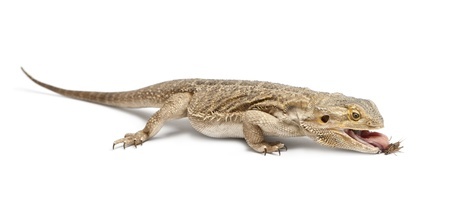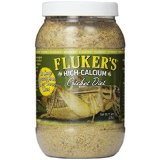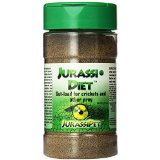The Bearded Dragon Diet
Bearded Dragons are omnivorous in nature meaning they eat both insect and plant material. They differ from most other reptiles as their eating habits change considerably throughout the course of their life. Bearded dragons start off as insectivores, eating approximately 80% insects and 20% vegetable matter. They become more and more dependant on fruit and vegetables as they age; eventually consuming approximately 20% of insects in their diet.
It is worth noting that juvenile reptiles have a higher water requirement. This is because insects provide very little in the way of moisture, unlike fruits and vegetables, however moist foods will dry out considerably in the vivarium if not eaten straight away.
Fresh water must always be provided in the vivarium. Many bearded dragons enjoy regular bathing and misting in warm water, away from the vivarium. This can also encourage eating, drinking and defecation if the reptile has been inappetant following recent illness or injury.
It is vital that their nutritional requirements are recognised for their life stage and the correct food is offered.
Reptiles will continue to eat until they are full. Problems occur when too much, low energy food is fed, filling their gut before their energy requirements are met.
Chronic protein deficiencies will also occur when reptiles are fed a high cellulose, low protein diet consisting of mainly lettuce and fruit. This may then lead to a general wasting condition with increased susceptibility to infections. Most of the protein they require comes from leafy greens such as dandelions, watercress, spring greens and rocket.
Grated carrot, bell peppers, courgettes and asparagus may be offered alongside these, with fruit such as apples or grapes given only as an occasional treat.
The reverse can happen if an energy dense diet is fed. The reptile will met their energy requirement relatively soon but continue eating until their gut capacity is filled. If they regularly exceed their energy requirement obesity will ensue.
Calcium requirements
A deficiency in calcium may cause metabolic bone disease or nutritional osteodystrophy. It is often accompanied with a vitamin D3 deficiency. Diets high in fruit, lettuce and celery are notoriously low in calcium.
Some foods such as spinach, beetroot and rhubarb leaves contain excessive calcium binding compounds, these prevent calcium being absorbed by the body, therefore these foods should be avoided.
Insectivorous juveniles fed on crickets without supplementation may also suffer from a calcium deficiency as insects contain little or no calcium.
To help prevent such deficiencies the insect must be dusted with a calcium powder immediately before being fed. Alternatively the insect can be fed on a calcium supplement, pre-loading their gut with calcium 24-48 hours prior to being offered to the reptile.
How to dust insects

The main problem with insect dusting is escapees to help combat this there are containers available like the Rep-cal cricket shaker available to buy on Amazon which you can use to coat your insects in calcium powder.
.jpg)
They can of course be dusted in a clear plastic bag. Simply add the amount of insects you require to the bag, tip in your calcium powder, there are many available on the market such examples are Exo Terra or Repashy. Shake the bag until the insects are completely coated in the powder they should look white like they are covered in ash then feed them immediately to your bearded dragon.
How to gut load your insects prior to feeding
Crickets and meal worms can both be gut loaded.
There are specially developed complete diets on the market for specifically gut loading feeder insects.
Two examples are:

Fluker’s High Calcium Cricket Feed

JurassiDiet Cricket Gut Load
To provide the insects with moisture you can add small pieces of raw fruit and vegetables.
Feed the insects 24-48 hours before offering them to your reptile.
Metabolic bone disease
This is where extensive resorption of calcium from the bones occurs. It is the bodies attempt to increase circulating blood calcium levels. When the calcium is resorbed it leaves only a fibrous tissue which is much weaker. To compensate, the bones thicken to try to maintain some strength, unfortunately this is no substitute for calcium and leads to weak bones, bowing of long bones, spontaneous fractures, collapsing of the spine and deformities.
An excessive calcium intake can be equally concerning, leading to mineralisation of soft tissues therefore it is vital to maintain a balance.
As a guide young bearded dragons should be fed 'to appetite' three times weekly with live insect prey such as crickets and locust. Live meal worms should only be offered occasionally.
Environmental temperature and lighting
As reptiles are unable to generate their own heat it is vital to keep their environmental temperature warm and stable. Every species of reptile have their optimum preferred temperature, which will allow their enzymes and metabolism to function at their optimum levels as temperature will influence the rate at which their food is digested.
Bearded dragons should be kept in an environmental temperature of 25-32 degrees C. As a guide the vivarium should be 35 degrees C under the heat source and 20-25 degrees C at the cool end.
It should have a relative humidity of between 25-50% which is around the normal levels of the average centrally heated home.
It is important to ensure only one end of the vivarium is heated so the dragon can move to a cooler zone to maintain their optimum preferred temperature.
Heat should ideally be controlled by a thermostat and thermometers placed at each end of the vivarium.
A radiant heat mat can be placed under the glass of one end of the vivarium and to provide a focal hot spot for basking, a protected ceramic or infra red heat bulb should be suspended from the ceiling.
UV-B/ UV-A lighting must be provided and placed inside the vivarium within 30-45 cm of the reptile. This should be on a timer switch set for 12-14 hours a day during daylight hours only as they must also have a period of darkness for 10-12 hours a day.
Inadequate light provision will result in low levels of vitamin D3 being produced, which can lead to calcium deficiencies.
It is vital to change the bulb every 6-9 months even if it appears to be working fine. This is because the quality of the UV-B/UV-A rays emitted will degrade over time.
Warning about vivarium plants
It is common practice to place artificial plants inside bearded dragon vivariums. These can and often are eaten by bearded dragons. Unfortunately this foreign material once eaten can cause gut impactions often requiring emergency surgery to prevent death of the reptile. We therefore advise against using artificial plants in bearded dragon vivariums. Should you choose to include them we urge that you regularly check the plants for signs of damage.
Contact us on 01254 53622 should you have any concerns about your reptiles health.
Written by Caroline Ashworth R.V.N (Head Nurse), Daisy Street Veterinary Centre, Blackburn 6th December 2014.

.jpg)
